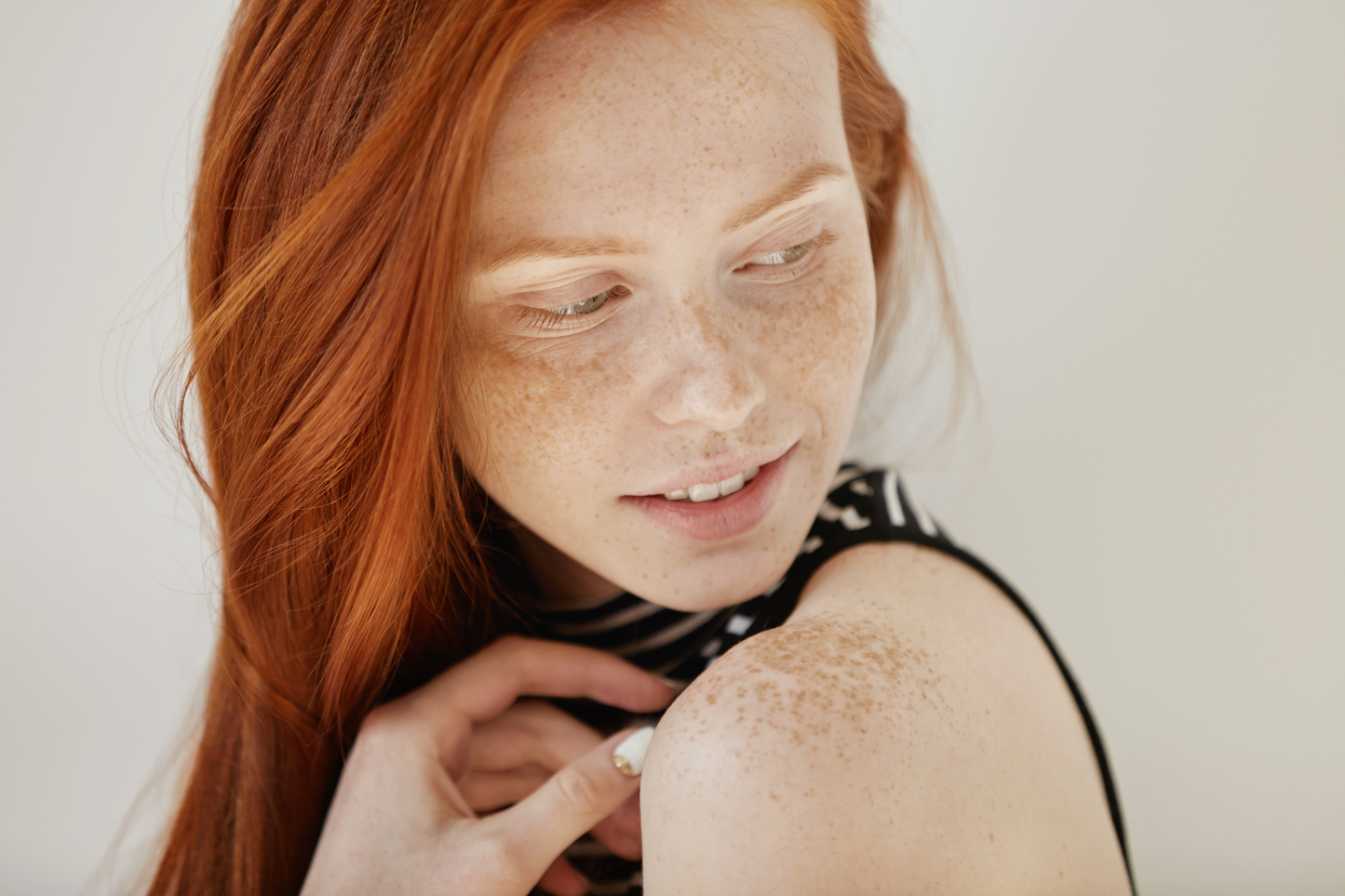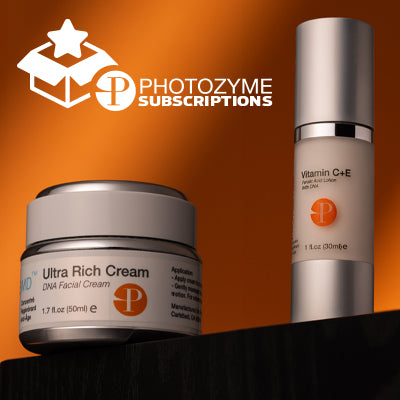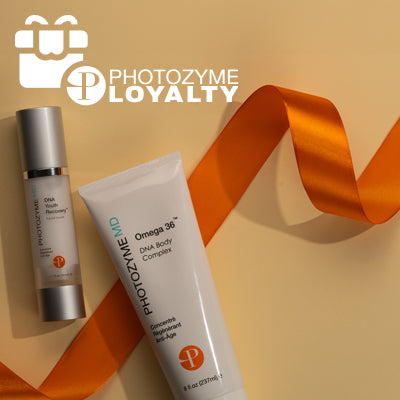
Find out what sun spots do look like, how to identify them, and learn innovative treatments for healthier, youthful skin. Learn more with Photozyme.
Key Takeaways:
- What Are Sun Spots? Sun spots, also known as solar lentigines, are flat, pigmented patches that result from cumulative exposure to ultraviolet (UV) radiation. They primarily affect areas frequently exposed to the sun.
- How To Differentiate Sun Spots From Skin Cancer: Differentiating sun spots from skin cancer is crucial. Sun spots are uniform in color and texture, whereas cancerous lesions often display asymmetry, irregular borders, and rapid changes.
- Treatment & Prevention Strategies: Effective treatment and prevention of sun spots involve topical solutions with antioxidants and retinoids, consistent sunscreen application, and understanding sun-safe practices.
Pigmentation changes can be subtle or stubborn, but knowing what do sun spots look like is the first step toward effective treatment. These flat, brown, or tan lesions often appear on sun-exposed areas and may be mistaken for freckles or melasma. Their presence signals cumulative UV damage that requires more than surface correction.
At Photozyme, we’ve built our reputation on scientific integrity and dermatological precision. Our patented DNA repair enzymes and clinically validated delivery systems are formulated to repair and protect at the cellular level. We collaborate with dermatologists, not marketing trends, to engineer solutions targeting the root causes of aging and photodamage.
In this blog, we’ll visually examine what sun spots look like, distinguish them from more serious skin conditions, and examine clinically supported treatment options that promote skin clarity, restore uniform tone, and prevent future UV-induced pigmentation.
Common Locations Of Sun Spots On The Skin
Sun spots, known clinically as solar lentigines, tend to appear where cumulative sun exposure is highest. The most common locations are those areas routinely exposed to ultraviolet (UV) rays over the years.
- Face: The face receives direct sunlight with every outdoor walk or commute. Cheeks, nose, forehead, and temples are especially prone to sun spots. If you ask what do sun spots look like on the face, these often appear as flat, light to dark brown patches, sometimes merging to form larger, uneven areas of pigmentation. Understanding sun spots vs freckles is essential here – freckles are typically smaller, lighter, and may fade with reduced sun exposure, while sun spots are more persistent and darken over time.
- Hands: Often called “age spots,” sun spots on the hands are prevalent because hands are frequently unprotected. The back of the hands becomes a visual diary of UV exposure, typically peppered with freckles or larger sun spots as one ages.
- Arms & Shoulders: Short sleeves and tank tops may feel liberating, but upper arms and shoulders absorb years of UV accumulation, making them prime territory for sun spots. These marks will often cluster in areas most exposed during outdoor activities.
- Chest & Décolletage: The upper chest and décolletage are highly susceptible, particularly in those who enjoy the outdoors or spend time in direct sun. Spots here develop gradually and might appear alongside other signs of photodamage, like rough texture or visible blood vessels.
- Back: While less visible to you directly, the upper back shoulders much of your sun exposure. Sun spots can appear here after years of minimal sunscreen or protective clothing.
- Legs & Feet: Swimsuits and shorts leave legs exposed. Over time, sun spots can emerge on the shins, calves, and the tops of the feet.
Sun spots favor these locations because UV radiation creates DNA lesions that trigger melanin production in the skin’s upper layers. Repeated exposure drives their persistence and spread, underscoring why prevention and diligent care are imperative for long-term skin health.
Methods To Identify Sun Spots At Home
Accurate identification of sun spots – also known as solar lentigines – requires a discerning eye and an understanding of how these marks differ from other forms of hyperpigmentation.
Here are several proven methods you can use at home:
Visual Examination In Natural Light
When researching what do sun spots on face look like, start by examining your skin under natural daylight, which allows subtle contrasts in pigment to become more visible. Sun spots typically present as small, flat patches with clearly defined borders. They range from light brown to dark brown and usually appear on sun-exposed areas such as the face, hands, shoulders, and arms.
Check For Symmetry And Texture
Sun spots are characteristically symmetrical and do not alter the texture of your skin. Run your fingers gently over the discolored areas – unlike some other types of pigmentation, sun spots are smooth and consistent with the surrounding skin.
Monitor Changes Over Time
Track new or existing patches for size, shape, or color changes. Sun spots develop gradually over months or years, contrasting with other skin marks that may change quickly or have irregular edges. Understanding the difference between sun spots vs. melanoma is key here: melanoma may evolve rapidly and present asymmetry, irregular borders, or multicolored appearance – warning signs that warrant immediate medical attention.
Use The ‘Glass Test’
Press a clear piece of glass gently against the area. Sun spots remain visible through the glass, while redness from inflammation or vascular issues tends to fade when pressure is applied.
Document And Compare
Take periodic photographs in standardized lighting to monitor the appearance of spots over time. Consistent documentation allows you to distinguish persistent sun spots from temporary skin changes caused by irritation or acne.
Self-assessment can be a powerful tool in early identification. Still, professional evaluation is crucial for any patches that change rapidly, itch, bleed, or have irregular borders, as these can be signs of more serious skin conditions.
Topical Solutions For Fading Sun Spots
Addressing sun spots demands a multi-pronged, science-driven approach, with topical treatments forming the cornerstone of most routines. An effective formula is based on its ability to disrupt melanin formation, accelerate cell turnover, and support natural DNA repair mechanisms – critical for minimizing visible discoloration and promoting a more even, youthful skin tone.
Key Ingredients And How They Work
- Vitamin C: As a powerful antioxidant and tyrosinase inhibitor, topical Vitamin C neutralizes free radicals and impedes the enzyme responsible for melanin production. Regular use targets hyperpigmentation while boosting overall skin radiance.
- Retinoids: By promoting cellular turnover, retinoids help shed pigmented, damaged surface cells. This process reveals fresher, clearer skin underneath, making retinoids one of the most researched and time-proven ingredients for addressing sun-induced spots.
- Niacinamide: Also known as Vitamin B3, niacinamide supports skin barrier function, diminishes visible discoloration, and soothes inflammation. It’s well tolerated by most skin types and pairs effectively with both Vitamin C and retinoids.
- Alpha Hydroxy Acids (AHAs): Glycolic acid and lactic acid, two leading AHAs, gently exfoliate the skin’s surface, speeding up the removal of unevenly pigmented cells. Consistent use enhances skin smoothness and luminosity.
- Growth Factors Or Peptides: These support skin’s repair processes and recovery, especially following UV exposure, minimizing the lasting impact of photodamage.
Safe Application And Best Practices
For optimal results – and to safeguard skin health – topical solutions should always be applied to clean, dry skin and introduced gradually. Layering antioxidants and DNA repair enzymes in the morning, followed by broad-spectrum sunscreen, creates proactive protection. Integrating gentle retinoids or AHAs in the evening supports ongoing pigment breakdown and cellular renewal.
Remember, fading sun spots is a gradual process. Consistency, patience, and a focus on clinically validated ingredients yield the most significant, sustainable transformation.
Preventing Sun Spots: Sun Protection Strategies
Shielding your skin from ultraviolet (UV) exposure is the cornerstone of effective sun spot prevention. Sun spots, or solar lentigines, form when UV radiation stimulates excess melanin production, leading to localized pigmentation. Preventive strategies must go beyond occasional sunscreen use to ensure ongoing protection against cumulative UV damage.
Daily Application Of Broad-Spectrum Sunscreen
Use a broad-spectrum sunscreen rated SPF 30 or higher as part of your daily skincare regimen. Reapply every two hours or immediately after swimming or perspiring. Pay close attention to often-missed areas, including the ears, lips, hands, and the eye contour zone, which are frequently exposed yet underprotected.
Enhancing Protection With Physical Barriers
Incorporate physical sun protection through wide-brimmed hats, UV-rated sunglasses, and tightly woven clothing. These layers reduce direct exposure and offer added protection during peak sunlight hours. When possible, choose garments and accessories labeled with an Ultraviolet Protection Factor (UPF) for verified defense against harmful rays.
Leveraging Technology To Track UV Exposure
Take advantage of technology by using smartphones or weather apps that track the daily UV index. Plan outdoor activities around times when UV exposure is lowest. For those working near windows, consider UV-filtering films or glass treatments, as UVA rays can still penetrate standard glass and contribute to long-term skin damage.
Building A Consistent, Informed Routine
Sustained adherence to these strategies helps prevent future sun spots and supports long-term skin health and uniformity in tone. Many patients also ask, Can you reverse sun damage? While some effects are permanent, proactive prevention paired with clinically proven treatments, like DNA repair enzymes and antioxidants, can improve pigmentation, texture, and skin clarity over time.
When To Consult A Dermatologist About Sun Spots
Not every sun spot warrants immediate concern, but understanding when to involve a dermatologist is key to maintaining long-term skin health. Flat, pigmented lesions can resemble harmless sun spots and mimic other dermatological conditions requiring closer examination.
Warning Signs That Merit Clinical Evaluation
Changes in color, shape, size, or sensation – such as itching, pain, or bleeding – should prompt a dermatologist visit. Lesions that develop irregular borders, uneven pigmentation, or continue evolving could indicate atypical skin behavior and must be assessed with diagnostic accuracy.
Risk Indicators And Age-Related Considerations
The sudden appearance of new pigmented spots after age 30 or rapid changes in pre-existing ones may suggest more than benign solar lentigines. Professional assessment helps differentiate sun spots from precancerous or malignant conditions, ensuring early intervention.
When Topical Treatments Are Not Enough
Clinical-grade therapies may be warranted if consistent use of preventive care and over-the-counter products yields no visible improvement after several months. A dermatologist can recommend targeted interventions, from prescription topicals to procedural treatments, based on a comprehensive evaluation of your skin’s condition and needs.
Supporting Skin Health Through Regular Check-Ups
Routine visits to a dermatologist facilitate early detection of skin irregularities and reinforce a proactive, science-backed approach to managing photodamage. These evaluations help ensure that your skincare strategy evolves in alignment with your skin’s ongoing biological changes and environmental exposures.
Final Thoughts
Understanding what sun spots look like – and recognizing their distinct features – is the first step in safeguarding your skin against the long-term effects of UV exposure. But true skin rejuvenation goes beyond identification. At Photozyme, we leverage clinically proven innovations, like DNA Enzyme Technology, to address the underlying damage that visual sun spots represent.
Our formulations, enriched with plant-derived DNA repair enzymes delivered through specialized liposomal systems, are designed to neutralize UV-induced DNA mutations and accelerate visible recovery. This science-driven approach supports your skin’s innate healing abilities for a healthier, more resilient complexion over time.
Commit to skincare that doesn’t settle for superficial change. With Photozyme, you invest in a future where science leads the way to vibrant, youthful skin, empowering you to move confidently into tomorrow.
Read also:
- Can Kojic Acid Permanently Lighten Skin? The Truth You Need To Know
- How To Layer Hyaluronic Acid And Retinol For Maximum Results
- Adapalene vs. Retinol: Which One Is Right For Your Skin?
Frequently Asked Questions About What Sun Do Spots Look Like
What are sun spots, and how do they form on the skin?
Sun spots, also known as solar lentigines or age spots, are flat, brown, or darkened patches that appear on areas of skin frequently exposed to the sun, such as the face, hands, and shoulders. These spots develop when ultraviolet (UV) radiation triggers an overproduction of melanin, the pigment responsible for skin color. Over time, repeated exposure and accumulated UV damage accelerate melanin clustering, leading to visible sun spots.
How can I distinguish sun spots from other skin spots?
Sun spots are typically round or oval, with clearly defined edges, and range from tan to dark brown. They’re usually uniform in color and flat to the touch, appearing in clusters or singly, most often on sun-exposed areas. In contrast, spots like acne marks, scars, or certain pigmentation changes can vary in texture, color, and shape. If you’re ever unsure, consult a dermatologist for a precise diagnosis.
Can sun spots appear on any skin type or tone?
Yes, sun spots can develop on all skin types and tones. While they might be more noticeable on lighter skin due to higher contrast, individuals with deeper skin tones are also susceptible to hyperpigmentation from UV exposure. The appearance may differ in hue and intensity, but the underlying cause – UV-induced melanin production – remains the same.
What is the difference between sun spots, freckles, and moles?
Freckles are small, light brown spots typically present from childhood and tend to fade without sun exposure. Sun spots, by contrast, are larger, darker, and persist throughout the year, regardless of sun exposure. Moles differ structurally – they are usually raised, can be any color from skin-toned to dark brown, and may have irregular borders or grow over time. Moles warrant closer monitoring for changes that could signal health concerns.
Can wearing sunscreen prevent the formation of sun spots?
Yes. Consistent daily use of a broad-spectrum sunscreen (SPF 30 or higher) significantly reduces UV exposure, helping to prevent the formation of new sun spots and limit worsening of existing ones. Sunscreen safeguards your skin’s DNA, which aligns directly with how Photozyme’s products deliver maximum benefit: by empowering natural repair and helping defend against future damage.
At what age do people usually start getting sun spots?
While sun spots become more common in individuals over 40, they can develop much earlier depending on UV exposure history, personal genetics, and skin type. Even those in their 20s and 30s may notice early sun spots if sun protection practices are inconsistent or if there is significant exposure to tanning beds or outdoor environments. Early intervention and daily preventative care are key.
Sources:
- Anna, B., Blazej, Z., Jacqueline, G., Andrew, C. J., Jeffrey, R., & Andrzej, S. (2007). Mechanism of UV-related carcinogenesis and its contribution to nevi/melanoma. Expert review of dermatology, 2(4), 451–469. https://doi.org/10.1586/17469872.2.4.451
- Almeman A. A. (2024). Evaluating the Efficacy and Safety of Alpha-Hydroxy Acids in Dermatological Practice: A Comprehensive Clinical and Legal Review. Clinical, cosmetic and investigational dermatology, 17, 1661–1685. https://doi.org/10.2147/CCID.S453243
- Zasada, M., & Budzisz, E. (2019). Retinoids: active molecules influencing skin structure formation in cosmetic and dermatological treatments. Postepy dermatologii i alergologii, 36(4), 392–397. https://doi.org/10.5114/ada.2019.87443





